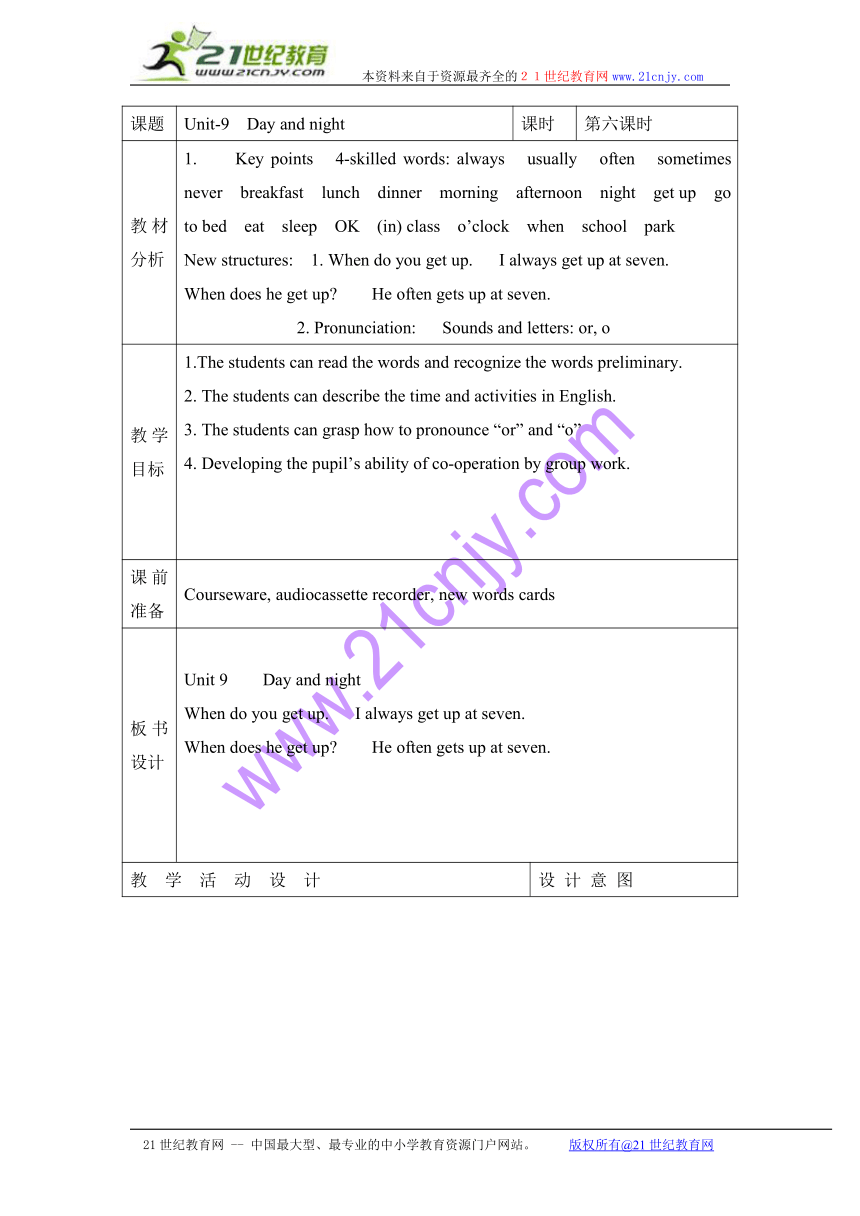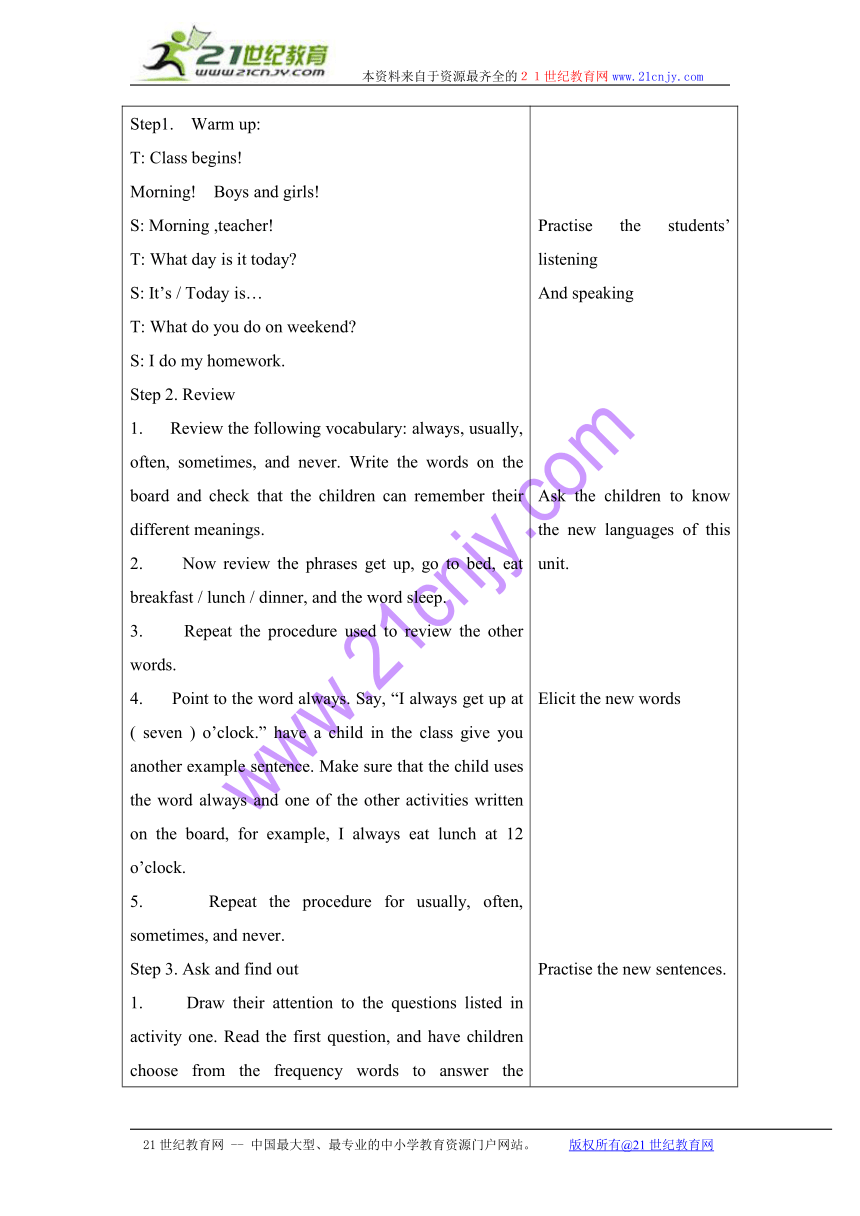四年级英语下册教案 unit9(6)(北师大版)
文档属性
| 名称 | 四年级英语下册教案 unit9(6)(北师大版) |  | |
| 格式 | rar | ||
| 文件大小 | 13.7KB | ||
| 资源类型 | 教案 | ||
| 版本资源 | 北师大版 | ||
| 科目 | 英语 | ||
| 更新时间 | 2010-02-23 13:26:00 | ||
图片预览


文档简介
本资料来自于资源最齐全的21世纪教育网www.21cnjy.com
课题 Unit-9 Day and night 课时 第六课时
教材分析 1. Key points 4-skilled words: always usually often sometimes never breakfast lunch dinner morning afternoon night get up go to bed eat sleep OK (in) class o’clock when school parkNew structures: 1. When do you get up. I always get up at seven. When does he get up He often gets up at seven. 2. Pronunciation: Sounds and letters: or, o
教学目标 1.The students can read the words and recognize the words preliminary.2. The students can describe the time and activities in English.3. The students can grasp how to pronounce “or” and “o”4. Developing the pupil’s ability of co-operation by group work.
课前准备 Courseware, audiocassette recorder, new words cards
板书设计 Unit 9 Day and nightWhen do you get up. I always get up at seven. When does he get up He often gets up at seven.
教 学 活 动 设 计 设 计 意 图
Step1. Warm up:T: Class begins!Morning! Boys and girls!S: Morning ,teacher!T: What day is it today S: It’s / Today is…T: What do you do on weekend S: I do my homework.Step 2. Review1. Review the following vocabulary: always, usually, often, sometimes, and never. Write the words on the board and check that the children can remember their different meanings.2. Now review the phrases get up, go to bed, eat breakfast / lunch / dinner, and the word sleep.3. Repeat the procedure used to review the other words.4. Point to the word always. Say, “I always get up at ( seven ) o’clock.” have a child in the class give you another example sentence. Make sure that the child uses the word always and one of the other activities written on the board, for example, I always eat lunch at 12 o’clock.5. Repeat the procedure for usually, often, sometimes, and never.Step 3. Ask and find out1. Draw their attention to the questions listed in activity one. Read the first question, and have children choose from the frequency words to answer the question. Tell the children to put a check in the box under the word they choose.2. Have the children look at the table at the bottom of the page. Tell them they need to interview two friends for the frequency they do the things listed in the table. 3. Copy the table onto the board. Ask a child, “Do you always eat breakfast ” Have the children answer, “I always eat breakfast.” Then write the word “always” in the table.4. Put children into groups and have them interview each other.5. At the end of the activity, call up individual child to report his / her findings.Step 4. Sounds and letters1. Draw the children’s attention to the pictures at the top of the page. Explain that they will hear words that have the “/ or /” or / o / sound.2. Play the tape and have the children say the words aloud.3. Check that the children’s pronunciation is correct by asking individual children to repeat the words after you, or after the tape.Step 5. Listen for sounds1. Direct the children’s attention to the middle part of the page. Show your copy of the page and point to the first row of pictures. Tell the children that three of the words have an / or / sound in them but one word doesn’t.2. Play the first four words on the tape. Have the children point to each picture illustrating a word with an / or / sound in it as they hear the word.3. Play the tape again. This time have the children cross the word without / or / sound in it.4. Repeat the procedure for the second row. Tell the children it is the / o / sound this time.Step 6. Read with Uncle Booky1. Direct children’s attention to the two rows of words at the bottom of the page. Show your copy of the page and point to the first row of words.2. Play the tape for the first four words. Have the children point to each word that they hear in the tape.3. Ask the children if they can find that all the words have an / or / sound.4. Tell the children to find out how to read the last two words.5. Play the tape for the last two words and have children repeat.6. Repeat with the / o / sound words.Step 7. extendHave the children find out some words with “or” or “o”, but they don’t have / or / or / o / soundStep 8. Sum up: Practise the students’ listening And speaking Ask the children to know the new languages of this unit. Elicit the new words Practise the new sentences. Raise the students using the sentences ability Consolidate the new words and the new sentences. Ask the children to know the new languages of this unit and at the same time, consolidate the key point for this unit.
作 业设 计 Must do: 1. Read the new text 5 times at home.2. Translate the text into Chinese.3. Preview page 36Choosing do: Find out some words with / or /.
教 学反 思 The children have grasped how to pronounce “or”, “o” and most of them can say out many words with “or” and “o”.
21世纪教育网 -- 中国最大型、最专业的中小学教育资源门户网站。 版权所有@21世纪教育网
课题 Unit-9 Day and night 课时 第六课时
教材分析 1. Key points 4-skilled words: always usually often sometimes never breakfast lunch dinner morning afternoon night get up go to bed eat sleep OK (in) class o’clock when school parkNew structures: 1. When do you get up. I always get up at seven. When does he get up He often gets up at seven. 2. Pronunciation: Sounds and letters: or, o
教学目标 1.The students can read the words and recognize the words preliminary.2. The students can describe the time and activities in English.3. The students can grasp how to pronounce “or” and “o”4. Developing the pupil’s ability of co-operation by group work.
课前准备 Courseware, audiocassette recorder, new words cards
板书设计 Unit 9 Day and nightWhen do you get up. I always get up at seven. When does he get up He often gets up at seven.
教 学 活 动 设 计 设 计 意 图
Step1. Warm up:T: Class begins!Morning! Boys and girls!S: Morning ,teacher!T: What day is it today S: It’s / Today is…T: What do you do on weekend S: I do my homework.Step 2. Review1. Review the following vocabulary: always, usually, often, sometimes, and never. Write the words on the board and check that the children can remember their different meanings.2. Now review the phrases get up, go to bed, eat breakfast / lunch / dinner, and the word sleep.3. Repeat the procedure used to review the other words.4. Point to the word always. Say, “I always get up at ( seven ) o’clock.” have a child in the class give you another example sentence. Make sure that the child uses the word always and one of the other activities written on the board, for example, I always eat lunch at 12 o’clock.5. Repeat the procedure for usually, often, sometimes, and never.Step 3. Ask and find out1. Draw their attention to the questions listed in activity one. Read the first question, and have children choose from the frequency words to answer the question. Tell the children to put a check in the box under the word they choose.2. Have the children look at the table at the bottom of the page. Tell them they need to interview two friends for the frequency they do the things listed in the table. 3. Copy the table onto the board. Ask a child, “Do you always eat breakfast ” Have the children answer, “I always eat breakfast.” Then write the word “always” in the table.4. Put children into groups and have them interview each other.5. At the end of the activity, call up individual child to report his / her findings.Step 4. Sounds and letters1. Draw the children’s attention to the pictures at the top of the page. Explain that they will hear words that have the “/ or /” or / o / sound.2. Play the tape and have the children say the words aloud.3. Check that the children’s pronunciation is correct by asking individual children to repeat the words after you, or after the tape.Step 5. Listen for sounds1. Direct the children’s attention to the middle part of the page. Show your copy of the page and point to the first row of pictures. Tell the children that three of the words have an / or / sound in them but one word doesn’t.2. Play the first four words on the tape. Have the children point to each picture illustrating a word with an / or / sound in it as they hear the word.3. Play the tape again. This time have the children cross the word without / or / sound in it.4. Repeat the procedure for the second row. Tell the children it is the / o / sound this time.Step 6. Read with Uncle Booky1. Direct children’s attention to the two rows of words at the bottom of the page. Show your copy of the page and point to the first row of words.2. Play the tape for the first four words. Have the children point to each word that they hear in the tape.3. Ask the children if they can find that all the words have an / or / sound.4. Tell the children to find out how to read the last two words.5. Play the tape for the last two words and have children repeat.6. Repeat with the / o / sound words.Step 7. extendHave the children find out some words with “or” or “o”, but they don’t have / or / or / o / soundStep 8. Sum up: Practise the students’ listening And speaking Ask the children to know the new languages of this unit. Elicit the new words Practise the new sentences. Raise the students using the sentences ability Consolidate the new words and the new sentences. Ask the children to know the new languages of this unit and at the same time, consolidate the key point for this unit.
作 业设 计 Must do: 1. Read the new text 5 times at home.2. Translate the text into Chinese.3. Preview page 36Choosing do: Find out some words with / or /.
教 学反 思 The children have grasped how to pronounce “or”, “o” and most of them can say out many words with “or” and “o”.
21世纪教育网 -- 中国最大型、最专业的中小学教育资源门户网站。 版权所有@21世纪教育网
